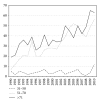The incidence of colorectal cancer is decreasing in the older age cohorts in the zaanstreek region in the Netherlands: an age-cohort effect
- PMID: 23936660
- PMCID: PMC3725760
- DOI: 10.1155/2013/871308
The incidence of colorectal cancer is decreasing in the older age cohorts in the zaanstreek region in the Netherlands: an age-cohort effect
Abstract
Introduction. Colorectal cancer (CRC) has a high incidence. Removal of adenomas, the precursor lesion, could be helpful in the prevention of cancer. Aim. To investigate the yearly incidence of CRC in consecutive years. Patients and Methods. All patients diagnosed with CRC in the years 1990 till 2010 were studied. Date of diagnosis, age at time of diagnosis, gender, and localisation of the tumour were assessed. Results. A total of 1575 incident CRC were diagnosed, 865 men (55%) and 710 women (45%). CRC occurred more often in men. In the course of the years, the occurrence of CRC increased. After exclusion of rectal cancer, the percentage of proximal cancer in the colon shows a trend towards increase in the consecutive years. In the twenty consecutive years, the population of the Zaanstreek region increased from 130.000 to 145.330. There was a significant increase of CRC in the age cohort 51-70 in the period of twenty years, while a significant decreasing incidence of cancer was seen in patients above 71 years. Conclusion. The decreasing incidence of colorectal cancer in the age cohorts above 71 years possibly reflects indirect evidence of an age-cohort effect due to removal of adenomas in these age cohorts earlier in life.
Figures











References
-
- Parkin DM, Bray F, Ferlay J, Pisani CA. Global cancer statistics 2002. CA: A Cancer Journal for Clinicians. 2005;55:74–18. - PubMed
-
- Seeff L, Ahmed F, King JB, Coughlin SS. Colorectal cancer incidence in the United states, 1999–2004. Cancer. 2009;115(9):1967–1976. - PubMed
-
- Hardcastle JD, Chamberlain JO, Robinson MHE, et al. Randomised controlled trial of faecal-occult-blood screening for colorectal cancer. The Lancet. 1996;348(9040):1472–1477. - PubMed
-
- Mandel JS, Church TR, Bond JH, et al. The effect of fecal occult-blood screening on the incidence of colorectal cancer. The New England Journal of Medicine. 2000;343(22):1603–1607. - PubMed
-
- Dutch Cancer registration, http://www.cijfersoverkanker.nl/
LinkOut - more resources
Full Text Sources
Other Literature Sources

